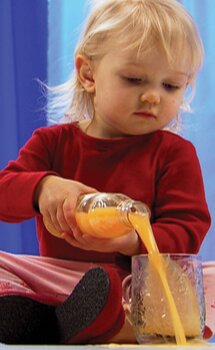Is your toddler getting into everything?
Has your “little angel” started coloring on your walls? Does she throw her cereal off her high chair even though you tell her not to? Chances are, you’re the proud parent of a 2-year-old!
The “terrible twos.”
People call this time the “terrible twos.” Why? Because 2-year-olds do many things that adults don’t want them to do. Sometimes they do things just because their parents tell them not to. You think your daughter is reading her book until you find her playing with the dirt in the house plant. Or, after you tell your son not to touch cans on the shelf in the grocery store, you hear a “plop, plop.” He has knocked two down and is rolling them down the aisle. Where is the child that used to listen?
Testing time.
Your child is growing up. His brain is developing. Babies think everyone wants and likes the same things they do. At about 18 months, toddlers understand that people think differently and like different things. They start learning what happens when people want different things. That’s when the testing begins. Your daughter looks directly at you and throws her oatmeal-filled spoon on the floor. There’s oatmeal everywhere. Or maybe she runs over and grabs the kitty’s tail even though she knows better.
Why do children do these things? Are they doing it to make you mad? Are they monsters?
Your child is not a monster.
This behavior is normal for toddlers. They don’t know if you will get mad or not or what you’re like when you’re upset. That’s the point. They are testing you so they can learn. They push your buttons because they need to know how you will respond. If you fail to respond or act in a way that confuses them – like smiling instead of clearly telling them what you expect – they may try again. If they push your buttons again, and this time you yell, they see something different. They might even try again. They want to know what it’s like when they push too far. They need to know where the family boundaries are and how firm they are. And they want to know how you react, so they can learn what to expect when there is trouble.
Success on the test.
What can you do to help them learn? Be consistent. Try not to raise your voice louder and louder with each test. Set clear boundaries for behavior and stick to them every time. By holding your ground when your son asks for ice cream before dinner, you teach him that there are firm limits around mealtimes. If you keep your cool when you take away the toy he’s throwing, he learns that throwing the toy is not okay and that you can be trusted to stay calm and take action – even when he loses control.
The big picture.
These tests can be hard, but it helps to remember that they serve a bigger purpose. It’s not always easy to keep calm and respond in a consistent way to your child, especially when it might be the fourth time she’s tested you in the last hour. Your child is learning about you. She’s learning what you expect from her and what you’re like when you’re upset with her. When you react to your child’s “bad behavior” by calmly and clearly letting her know the rules instead of yelling or screaming, you teach her that you are consistent, fair, and firm. The end result is that your child learns to trust you.
Helpful parenting tips
Your child is also learning what is safe to do and what is not. She may want to try something dangerous. She may run into the street, jump into a lake or pool, or put something harmful into her mouth. Kids are curious about everything. It is up to you and the other adults who care for her to watch her at all times and keep her safe.
- Expect your toddler to test you often. This is normal. She is curious and learning how to react when she tries something you don’t want her to do.
- Every time your child tests you, try to respond consistently and lovingly. Clear and firm boundaries for behavior are best.
- Provide safe ways for your toddler to explore and test.
- When you are tired of her dumping her cereal on the floor to watch it scatter, take her out of the high chair and think of another way she can explore. If dumping seems fun, fill a low drawer in the kitchen with plastic containers, spoons, measuring cups, and other safe items to fill up and dump out.
Remember that your curious child is testing everything – including you. Hang in there! The trying times of the terrible twos don’t last forever.

